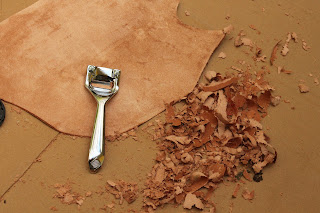The number one most requested thing for me to teach is leather maskmaking. I learned by reading books and screwing up a lot. With any luck, I can spare you some of that.
 Commedia del Arte
Commedia del Arte is a
form of theater designed to be performed by a limited number of actors
in a setting that is less than ideal for theater: The Renaissance
marketplace.
Each actor wears a specific mask and adopts certain prescribed poses that are universal to the form.
The characters bear names like
Pantalone, the unscrupulous and grasping old man;
Capitano, the strutting braggart;
Arlechinno,
the clever and (more or less) innocent servant...
The iconic masks, poses and well-defined characters allowed the actors
to perform amid the bustle of marketplace and festival in a time before
microphones. The cavernous noses of the masks have even been alleged to magnify the voices of the actors. . . though I've worn one for years in performances and I can't say as I buy that argument entirely.
Even if you could not hear every word or see them clearly, you
knew who
was doing what. Even from a distance, there was no question which
actor was playing which role, so well-known were the archetypes they
portrayed. Even today you would recognize them whether you realize it
or not. Harlequin came from commedia. Punch & Judy as well.
Shakespeare borrowed shamelessly from his Italian counterparts. Pants are called "pants" as a short form of 'pantaloons' named for the
costume worn by
Pantalone.
In
more theatrical and modern(ish) terms, The Marx Brothers, Monty Python
and the Muppets all owe an enormous debt to their frenetic forbears in
commedia del arte.
Traditional Italian commedia masks were leather like the one I am wearing above, wetformed over wooden forms. That's the sort that I'm about to show you how to make.
If you don't have the knack or the interest in carving, rest assured that you can create a mask in clay and then make a positive mold as shown in the YouTube video below, only instead of using fiberglass, fill your mold with the fine concrete used to make stepping stones. You can then form your leather over that.
The video...
Not only is that okay, it's how Thurston James advises you to proceed in his book The Prop Builder's Mask-Making Handbook (sadly out of print, but still available here and there if you look hard enough) which many consider to be the book on the topic. He hates carving things out of wood, but advises leaving hollows in the back of the mask and eyes to fill with plastic wood for the later steps involving nails.
Unlike Mr. Thurston
James, I actually enjoy hand-carving and own all the necessary tools to
do so, so that is how I intend to proceed. If you don't care to join
me, you're on your own, I fear, though later lessons about the molding
are universally applicable.
But I'm getting ahead of myself already.
So many people protested when I said I was giving up fooling, I wanted to create a poppet or doll in the costume of Calabash.so that he'd still be around. So I'll be making a 1/3 scale version of my mask (pictured below).
All of the following steps will be identical on a full-sized mask, or even for a smaller one. These things can get as small as you choose to make them, though the smaller you get, the less you shall be able to attain intricate details.
When asked how he sculpted The Thinker, Rodin said he just cut away everything that wasn't his statue and when he was done, voila! I'm not sure that a blog like this is the place to learn woodcarving, but I shall do my best.
The tools I used were a saw, a rasp, and a knife. Keep them all sharp. Be cautious. Wear protective gear as appropriate. Proceed at your own risk.
All carvings begin the same way as Rodin. Woodcarving is just sculpture in a reluctant medium... with a simple block of wood. In this case, I used a chunk of scrap pine.
As the Maestro said, the first thing is to draw the shape on the block and then cut away everything that is not mask. Use a coping saw if you're attached to the notion of period perfection or a power saw if you have one.
Use a rasp or file to begin beveling edges and beginning to shape the cheekbones, making the mask into a three-dimensional form.
Once I had the basic shape, I used dowels to attach a piece of 2x2 to make the nose as shown in the profile plan below. I don't have any pictures of that, but the it's really just drill a hole and insert wood and a dowel.
Then continue carving until I had this...
Next, we'll get into some leatherwork, at long last























